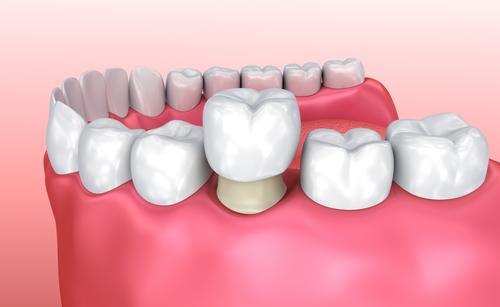
A dental crown is a dental prosthesis crafted from an artificial tooth piece and implanted in place of a broken natural tooth. Its purpose is to repair and protect a damaged tooth. If you have a loose crown, it’s crucial to address it promptly to prevent further harm. Before delving into what to do when a dental crown is loose, let’s first explore what causes it.
Causes of a Loose Dental Crown
There are several reasons why a dental crown may become loose or even detached. These include:
- Underlying tooth decay beneath the crown.
- Trauma to the crown.
- Grinding or clenching habits.
- Sticky foods.
- Lack of proper dental care.
- Technician error from your dentist or the laboratory.
- The crown is too large.
The primary reason crowns detach is underlying decay that eventually fractures the crown portion. If this is the case, tooth extraction may be necessary, and a replacement option with a dental implant might be required.
Immediate Steps When Your Crown is Loose
A loose dental crown can be considered a dental emergency, especially if you’re experiencing intense pain. Here’s what you should do in such a situation:
Attempt to remove it, inspect, clean, and reposition if possible.
When your dental crown begins to loosen or detach, grip it firmly between your fingers and try to gently remove it yourself. If you manage to take off the crown or if it falls off by itself, inspect its inner surface to check if any part of your tooth is loosened. If the loose crown has cleanly detached, it will be much easier to replace.
Once the crown is out of your mouth, gently brush it with a toothbrush. Use a toothpick to remove any residue or cement. If nothing is obstructing the crown, try placing it back into your mouth. If it fits well, you can wear the crown during the day as long as you avoid chewing on that side of the mouth. This is only a temporary solution, of course.
However, refrain from using household glue or other adhesives to try to reattach your crown. They will do more harm than good. There are over-the-counter oral adhesives available, but they don’t work very well and only provide a short-term solution.
Schedule an appointment with your dentist:
Call your dentist and inform them about the loose crown. Schedule an appointment so they can examine your teeth and determine why the crown detached and the extent of the damage.
If you can’t see your dentist for a few days and the tooth is very sensitive without the crown, you can call the dental office to inquire about using temporary dental cement. This cement is a temporary solution, but it can hold the crown in place for a while until you see the dentist. Securing the crown with temporary cement can protect your dentin from abrasion and decay. It can also reduce sensitivity to hot or cold foods.
If the dental crown is broken and your tooth is too sensitive, you can isolate the area with sugar-free chewing gum or a bit of dental cement. However, this solution will only help alleviate discomfort for a few hours until you see your dentist.
Preventing Crown Movement
Although dental crowns are made of durable material, the cement can only last for a limited time. Older crowns need to be replaced at some point, regardless of the precautions you take. To make the most of your dental crown, be cautious when eating sticky or hard foods and follow good oral hygiene habits such as brushing your teeth at least twice a day and flossing. If you grind or clench your teeth, your dentist may recommend using a mouthguard.

